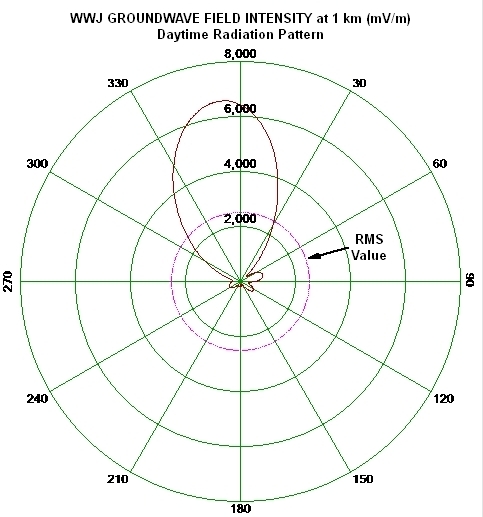Some registered account users are experiencing password recognition issues. The issue appears to have been triggered by a PHP update last night. If this is occurring, please try logging in and using the "forgot password?" utility. Bear in mind auto-generated password reset emails may appear in your spam folder. If this does not work, please click the "Contact Us" option near the lower right hand corner of the index page to contact me via email.
Thank you for your patience!
- M.W.
Thank you for your patience!
- M.W.
WJR-WWJ Daytime Groundwave vs. Distance Comparison
Re: WJR-WWJ Daytime Groundwave vs. Distance Comparison
It depends on how much goes out above the horizon. A lot and the Horizontal is reduced. Not much and the Horizontal is increased, for a given power radiated. You have to integrate the whole 3D surface area radiated into, not just the Horizontal. When I have more time, I'll link the graph from the 1960 NAB Handbook that shows this.
Is THAT where they got the idea for the 486-SX?
Same (x, y, z), different (t)
Your bullet missed my trial balloon.
RTN Price. Not guaranteed. As of 12:30, 157.71 Down 0.22.
Artificial Intelligence is a Child that needs a Parent to guide it through.
Same (x, y, z), different (t)
Your bullet missed my trial balloon.
RTN Price. Not guaranteed. As of 12:30, 157.71 Down 0.22.
Artificial Intelligence is a Child that needs a Parent to guide it through.
Re: WJR-WWJ Daytime Groundwave vs. Distance Comparison
An old analogy about this is that an inflated spherical balloon, when squeezed, still has the same volume within it that it had before it was squeezed. (Internal pressure makes a difference, but that is ignored for the purpose of this analogy.)
Below is a plot of the field intensity in mV/m radiated by the daytime pattern of WWJ in the horizontal plane, created from downloading CDBS data for it from the FCC website.
The RMS value of the pattern is displayed by the red circle there, showing an omnidirectional pattern having the same internal area as within the directional pattern.

Re: WJR-WWJ Daytime Groundwave vs. Distance Comparison
The text and graphic in the post next above was edited to better describe the point being made (hopefully).
Re: WJR-WWJ Daytime Groundwave vs. Distance Comparison
If you determined the RMS at each elevation angle above the horizon, every 5 degrees from zero all the way up to 90 degrees(that's zero, the cone of silence, but you still need it in the calculation for proper mathematical integration), you would get the RMS for the whole pattern, which should be the hemispherical equivalent of 50000 watts, radiated into a hemisphere above the ground plane. That's a power factor of two over isotropic, since its radiated into a hemisphere and not a sphere. According to my calculations, that's 244.94 mV/m @ 1 kW @ 1 km.
Last edited by CK-722 on Sat Oct 26, 2019 5:19 pm, edited 1 time in total.
Is THAT where they got the idea for the 486-SX?
Same (x, y, z), different (t)
Your bullet missed my trial balloon.
RTN Price. Not guaranteed. As of 12:30, 157.71 Down 0.22.
Artificial Intelligence is a Child that needs a Parent to guide it through.
Same (x, y, z), different (t)
Your bullet missed my trial balloon.
RTN Price. Not guaranteed. As of 12:30, 157.71 Down 0.22.
Artificial Intelligence is a Child that needs a Parent to guide it through.
Re: WJR-WWJ Daytime Groundwave vs. Distance Comparison
Below is a clip from the FCC website showing the daytime RMS field of WWJ at a horizontal distance of 1 km, for 50 kW of transmitter power.
The RMS value in my earlier graphic agrees nicely with the RMS values shown in the FCC data for WWJ.

The RMS value in my earlier graphic agrees nicely with the RMS values shown in the FCC data for WWJ.

Re: WJR-WWJ Daytime Groundwave vs. Distance Comparison
On Page 2-134 of the 1960 NAB Engineering Handbook, there is a graph which shows the effect of tower spacing and phase on the horizontal RMS for a simple two tower array with 1/4 wave towers. To put it in a simple example, cardioid patterns put more power in the horizontal plane than broadside patterns do. Broadside arrays put more power above the horizontal plane than cardioid arrays. The maximum horizontal gain is for about 45 degrees separation with 180 degree phase difference, which results in a Figure 8 pattern. A minimum is reached with 180 degree spacing and zero phase difference. This is also a Figure 8 pattern, but with much narrower lobes. Power is radiated in the null directions above the horizontal plane. This is where the power goes compared to a cardioid, or even a Figure 8 with 180 degrees phase difference.
https://www.americanradiohistory.com/Ar ... tion-3.pdf
https://www.americanradiohistory.com/Ar ... tion-3.pdf
Is THAT where they got the idea for the 486-SX?
Same (x, y, z), different (t)
Your bullet missed my trial balloon.
RTN Price. Not guaranteed. As of 12:30, 157.71 Down 0.22.
Artificial Intelligence is a Child that needs a Parent to guide it through.
Same (x, y, z), different (t)
Your bullet missed my trial balloon.
RTN Price. Not guaranteed. As of 12:30, 157.71 Down 0.22.
Artificial Intelligence is a Child that needs a Parent to guide it through.